fuel type Lancia Ypsilon 2012 Owner handbook (in English)
[x] Cancel search | Manufacturer: LANCIA, Model Year: 2012, Model line: Ypsilon, Model: Lancia Ypsilon 2012Pages: 307, PDF Size: 13.3 MB
Page 8 of 307
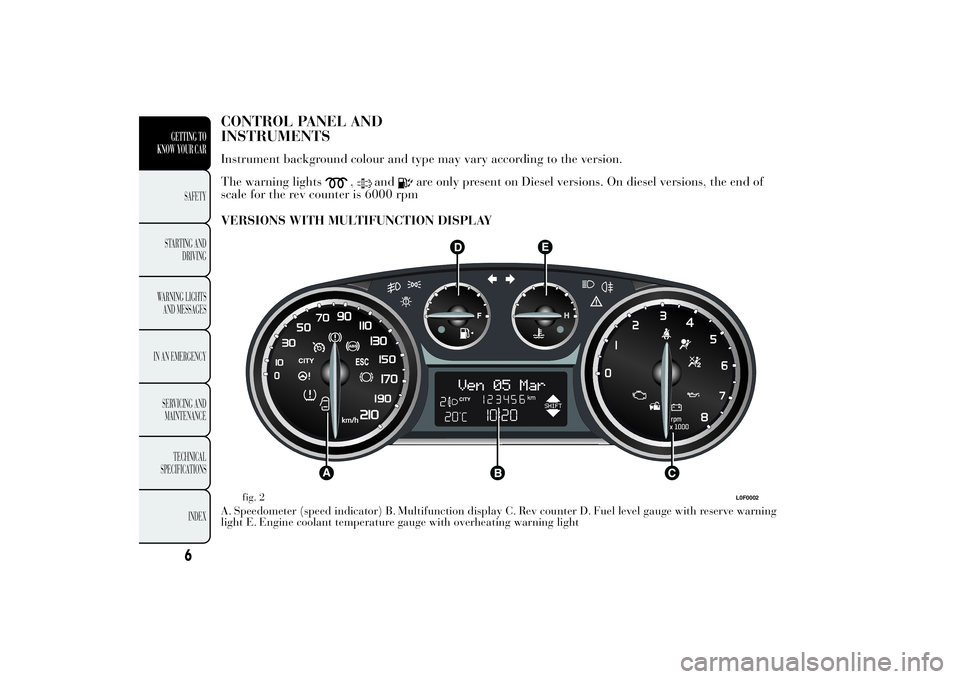
CONTROL PANEL AND
INSTRUMENTSInstrument background colour and type may vary according to the version.
The warning lights
,
and
are only present on Diesel versions. On diesel versions, the end of
scale for the rev counter is 6000 rpm
VERSIONS WITH MULTIFUNCTION DISPLAY
A. Speedometer (speed indicator) B. Multifunction display C. Rev counter D. Fuel level gauge with reserve warning
light E. Engine coolant temperature gauge with overheating warning light
fig. 2
L0F0002
6
GETTING TO
KNOW YOUR CAR
SAFETY
STARTING AND
DRIVING
WARNING LIGHTS
AND MESSAGES
IN AN EMERGENCY
SERVICING AND
MAINTENANCE
TECHNICAL
SPECIFICATIONS
INDEX
Page 26 of 307

TRIP COMPUTERGeneral information
The Trip computer is used to display information
on car operation when the key is turned to
MAR-ON. This function allows you to define two
separate trips, called “Trip A” and “Trip B”,
for monitoring the car's "complete mission"
(journey) in a reciprocally independent manner.
Both functions are resettable (reset - start of a new
journey).
“Trip A” is used to display the figures relating to:
❒Outside temperature (for LPG/Natural Power
versions equipped with multifunction display)
❒Range
❒Distance travelled
❒Average consumption
❒Instantaneous consumption
❒Average speed
❒Trip time (driving time).
“Trip B” may be used to display the figures
relating to:
❒Distance travelled B
❒Average consumption B
❒Average speed B
❒Trip time B (driving time).Note“Trip B” may be disabled (see “Activating
Trip B”). “Range” and “Instantaneous fuel
consumption" parameters cannot be reset.
Values displayed
Range
This indicates the approximate distance which can
be travelled with the amount of fuel present in
the tank. “----”will appear on the display in the
following cases:
❒range value lower than 50 km (or 30 mi)
❒car parked with engine running for a long
period.
IMPORTANT The range value variation can be
affected by several factors: driving style, type
of route (motorway, towns and cities, mountain
roads, etc.), conditions of use (load, tyre pressures,
etc.). Trip planning must therefore take the above
into account.
24GETTING TO
KNOW YOUR CAR
SAFETY
STARTING AND
DRIVING
WARNING LIGHTS
AND MESSAGES
IN AN EMERGENCY
SERVICING AND
MAINTENANCE
TECHNICAL
SPECIFICATIONS
INDEX
Page 118 of 307
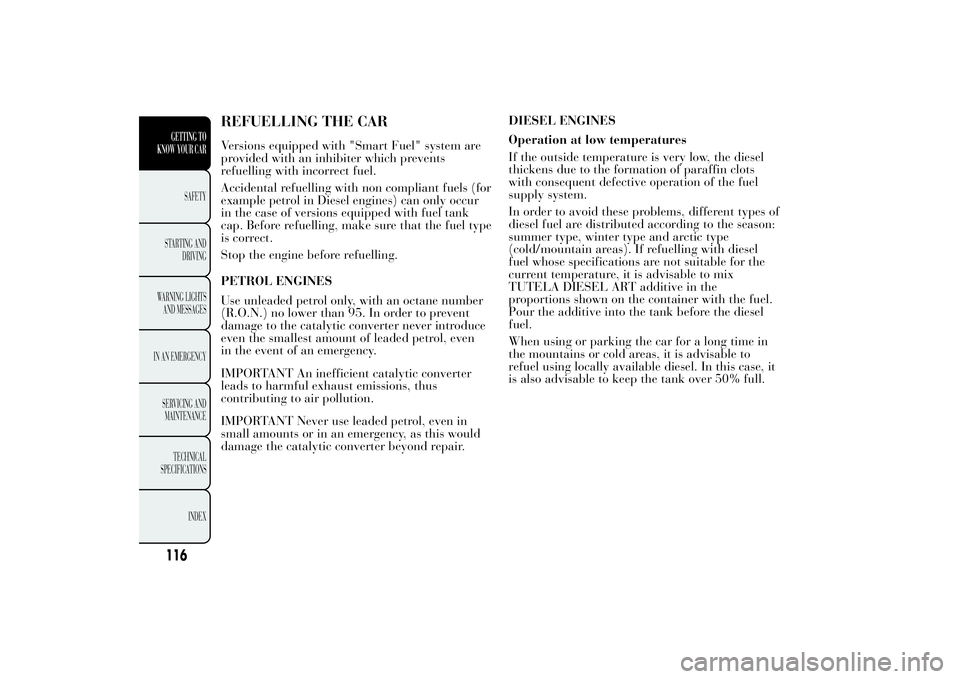
REFUELLING THE CARVersions equipped with "Smart Fuel" system are
provided with an inhibiter which prevents
refuelling with incorrect fuel.
Accidental refuelling with non compliant fuels (for
example petrol in Diesel engines) can only occur
in the case of versions equipped with fuel tank
cap. Before refuelling, make sure that the fuel type
is correct.
Stop the engine before refuelling.
PETROL ENGINES
Use unleaded petrol only, with an octane number
(R.O.N.) no lower than 95. In order to prevent
damage to the catalytic converter never introduce
even the smallest amount of leaded petrol, even
in the event of an emergency.
IMPORTANT An inefficient catalytic converter
leads to harmful exhaust emissions, thus
contributing to air pollution.
IMPORTANT Never use leaded petrol, even in
small amounts or in an emergency, as this would
damage the catalytic converter beyond repair.DIESEL ENGINES
Operation at low temperatures
If the outside temperature is very low, the diesel
thickens due to the formation of paraffin clots
with consequent defective operation of the fuel
supply system.
In order to avoid these problems, different types of
diesel fuel are distributed according to the season:
summer type, winter type and arctic type
(cold/mountain areas). If refuelling with diesel
fuel whose specifications are not suitable for the
current temperature, it is advisable to mix
TUTELA DIESEL ART additive in the
proportions shown on the container with the fuel.
Pour the additive into the tank before the diesel
fuel.
When using or parking the car for a long time in
the mountains or cold areas, it is advisable to
refuel using locally available diesel. In this case, it
is also advisable to keep the tank over 50% full.
116GETTING TO
KNOW YOUR CAR
SAFETY
STARTING AND
DRIVING
WARNING LIGHTS
AND MESSAGES
IN AN EMERGENCY
SERVICING AND
MAINTENANCE
TECHNICAL
SPECIFICATIONS
INDEX
Page 119 of 307
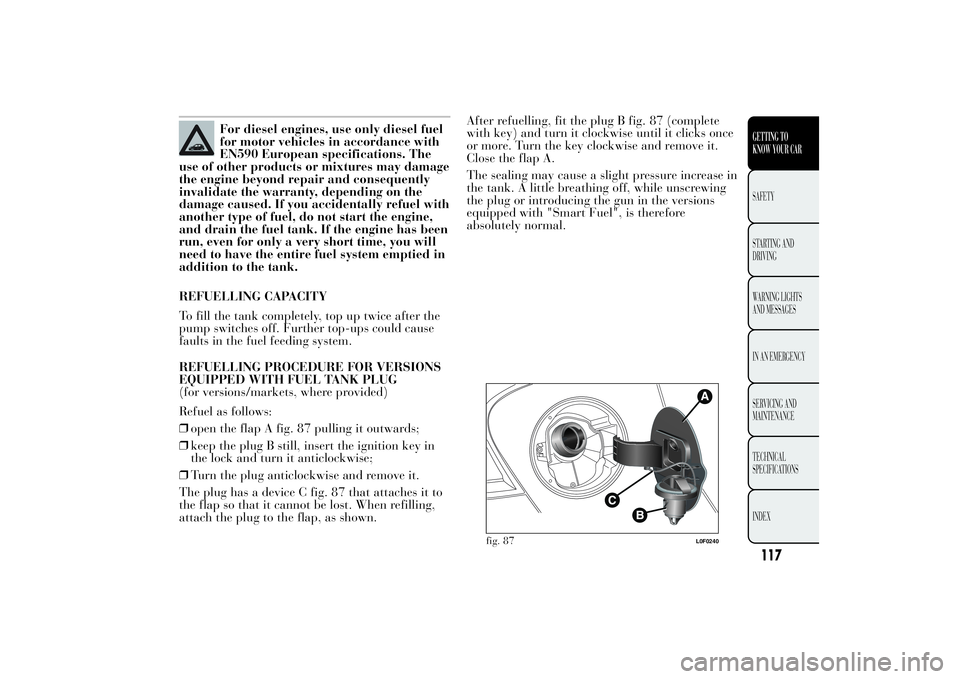
For diesel engines, use only diesel fuel
for motor vehicles in accordance with
EN590 European specifications. The
use of other products or mixtures may damage
the engine beyond repair and consequently
invalidate the warranty, depending on the
damage caused. If you accidentally refuel with
another type of fuel, do not start the engine,
and drain the fuel tank. If the engine has been
run, even for only a very short time, you will
need to have the entire fuel system emptied in
addition to the tank.
REFUELLING CAPACITY
To fill the tank completely, top up twice after the
pump switches off. Further top-ups could cause
faults in the fuel feeding system.
REFUELLING PROCEDURE FOR VERSIONS
EQUIPPED WITH FUEL TANK PLUG
(for versions/markets, where provided)
Refuel as follows:
❒open the flap A fig. 87 pulling it outwards;
❒keep the plug B still, insert the ignition key in
the lock and turn it anticlockwise;
❒Turn the plug anticlockwise and remove it.
The plug has a device C fig. 87 that attaches it to
the flap so that it cannot be lost. When refilling,
attach the plug to the flap, as shown.After refuelling, fit the plug B fig. 87 (complete
with key) and turn it clockwise until it clicks once
or more. Turn the key clockwise and remove it.
Close the flap A.
The sealing may cause a slight pressure increase in
the tank. A little breathing off, while unscrewing
the plug or introducing the gun in the versions
equipped with "Smart Fuel", is therefore
absolutely normal.
fig. 87
L0F0240
117GETTING TO
KNOW YOUR CARSAFETY
STARTING AND
DRIVING
WARNING LIGHTS
AND MESSAGES
IN AN EMERGENCY
SERVICING AND
MAINTENANCE
TECHNICAL
SPECIFICATIONS
INDEX
Page 120 of 307

REFUELLING PROCEDURE FOR VERSIONS
EQUIPPED WITH "SMART FUEL" SYSTEM
"Smart Fuel" is a device integrated with the end
of the fuel filler pipe which opens and recloses
automatically when the fuel delivery gun is
introduced/removed. "Smart Fuel" is provided
with an inhibiter which prevents refuelling with
incorrect fuel.
The refuelling procedure described here is
illustrated on label B fig. 88, which is applied
inside the fuel flap. The label also indicates the
fuel type (UNLEADED FUEL=petrol,
DIESEL=diesel fuel).
To refuel proceed as follows:
❒open the flap A fig. 88 pulling it outwards;
❒introduce the dispenser in the filler and refuel;
❒at the end of refuelling, before removing the
dispenser, wait for at least 10 in order for the
fuel to flow inside the tank;
❒then remove the dispenser from the filler and
close the flap A.
Flap A fig. 88 is provided with a dust cowl C
which prevents deposits of impurities and dust at
the end of the filler when the flap is closed.
fig. 88
L0F0085
118GETTING TO
KNOW YOUR CAR
SAFETY
STARTING AND
DRIVING
WARNING LIGHTS
AND MESSAGES
IN AN EMERGENCY
SERVICING AND
MAINTENANCE
TECHNICAL
SPECIFICATIONS
INDEX
Page 152 of 307
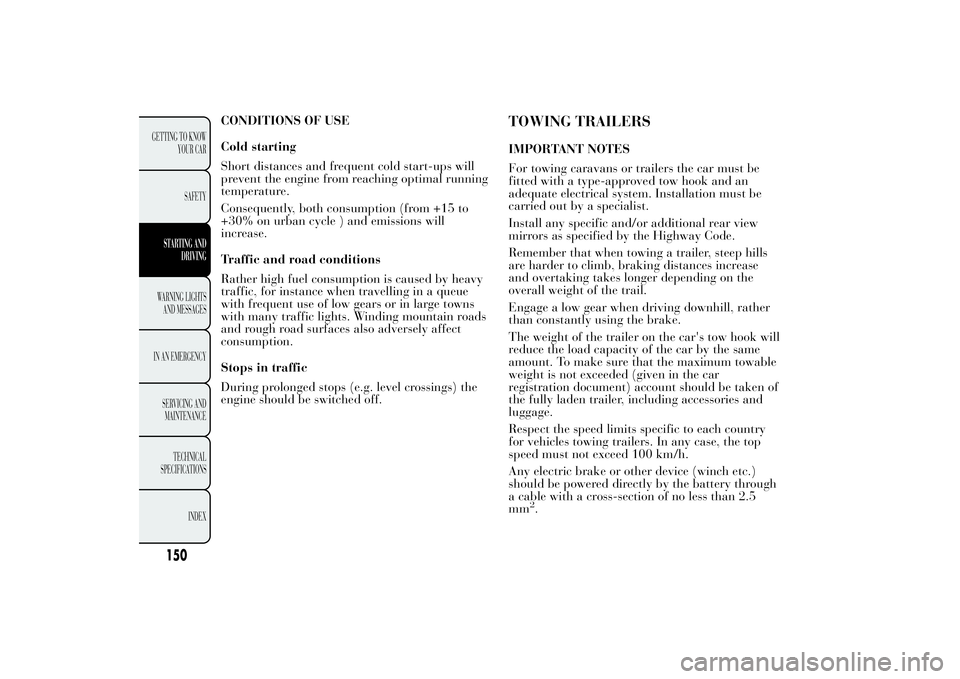
CONDITIONS OF USE
Cold starting
Short distances and frequent cold start-ups will
prevent the engine from reaching optimal running
temperature.
Consequently, both consumption (from +15 to
+30% on urban cycle ) and emissions will
increase.
Traffic and road conditions
Rather high fuel consumption is caused by heavy
traffic, for instance when travelling in a queue
with frequent use of low gears or in large towns
with many traffic lights. Winding mountain roads
and rough road surfaces also adversely affect
consumption.
Stops in traffic
During prolonged stops (e.g. level crossings) the
engine should be switched off.
TOWING TRAILERSIMPORTANT NOTES
For towing caravans or trailers the car must be
fitted with a type-approved tow hook and an
adequate electrical system. Installation must be
carried out by a specialist.
Install any specific and/or additional rear view
mirrors as specified by the Highway Code.
Remember that when towing a trailer, steep hills
are harder to climb, braking distances increase
and overtaking takes longer depending on the
overall weight of the trail.
Engage a low gear when driving downhill, rather
than constantly using the brake.
The weight of the trailer on the car's tow hook will
reduce the load capacity of the car by the same
amount. To make sure that the maximum towable
weight is not exceeded (given in the car
registration document) account should be taken of
the fully laden trailer, including accessories and
luggage.
Respect the speed limits specific to each country
for vehicles towing trailers. In any case, the top
speed must not exceed 100 km/h.
Any electric brake or other device (winch etc.)
should be powered directly by the battery through
a cable with a cross-section of no less than 2.5
mm
2.
150
GETTING TO KNOW
YOUR CAR
SAFETY
STARTING AND
DRIVINGWARNING LIGHTS
AND MESSAGES
IN AN EMERGENCY
SERVICING AND
MAINTENANCE
TECHNICAL
SPECIFICATIONS
INDEX
Page 252 of 307

FUEL CONSUMPTIONThe fuel consumption figures given in the table below are determined on the basis of the type-approval
tests laid down by specific European Directives.
The following procedures are followed to measure consumption:
❒urban cycle: cold starting followed by driving that simulates urban use of the car;
❒extra-urban cycle: frequent accelerating in all gears, simulating extraurban use of the car: speed
varies between 0 and 120 km/h;
❒combined fuel consumption: calculated with a weighting of approximately 37% of the urban cycle
and 63% of the extra-urban cycle.
IMPORTANT The type of route, traffic conditions, weather conditions, driving style, general condition
of the car, trim level/equipment/accessories, use of the climate control, car load, presence of roof racks
and other situations that adversely affect the aerodynamics or wind resistance lead to different fuel
consumption figures than those measured.
FUEL CONSUMPTION ACCORDING TO THE CURRENT EUROPEAN DIRECTIVE (litres/100
km)Versions Urban Extra-urban Combined
0.9 TwinAir 85 HP5.0 3.8 4.2
1.2 8V 69 HP6.4 4.1 4.9
1.3 16V MultiJet4.7 3.2 3.8
250
GETTING TO KNOW
YOUR CAR
SAFETY
STARTING AND
DRIVING
WARNING LIGHTS
AND MESSAGES
IN AN EMERGENCY
SERVICING AND
MAINTENANCE
TECHNICAL
SPECIFICATIONS
INDEX
Page 304 of 307
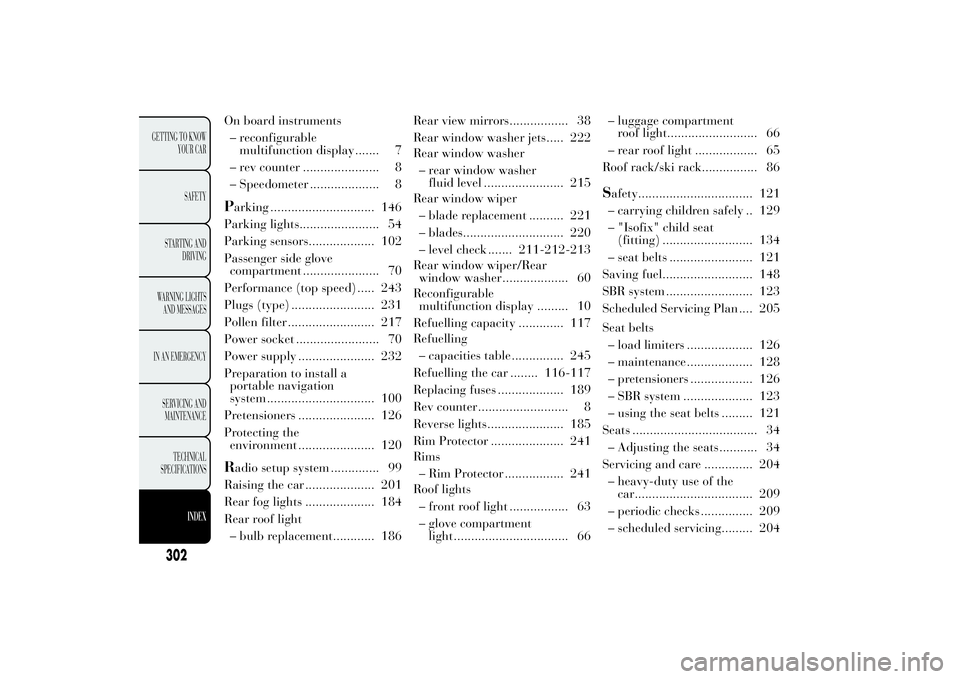
On board instruments
– reconfigurable
multifunction display ....... 7
– rev counter ...................... 8
– Speedometer .................... 8Parking .............................. 146
Parking lights....................... 54
Parking sensors................... 102
Passenger side glove
compartment ...................... 70
Performance (top speed) ..... 243
Plugs (type) ........................ 231
Pollen filter ......................... 217
Power socket ........................ 70
Power supply ...................... 232
Preparation to install a
portable navigation
system ............................... 100
Pretensioners ...................... 126
Protecting the
environment ...................... 120Radio setup system .............. 99
Raising the car .................... 201
Rear fog lights .................... 184
Rear roof light
– bulb replacement............ 186Rear view mirrors................. 38
Rear window washer jets..... 222
Rear window washer
– rear window washer
fluid level ....................... 215
Rear window wiper
– blade replacement .......... 221
– blades............................. 220
– level check ....... 211-212-213
Rear window wiper/Rear
window washer ................... 60
Reconfigurable
multifunction display ......... 10
Refuelling capacity ............. 117
Refuelling
– capacities table ............... 245
Refuelling the car ........ 116-117
Replacing fuses ................... 189
Rev counter .......................... 8
Reverse lights...................... 185
Rim Protector ..................... 241
Rims
– Rim Protector ................. 241
Roof lights
– front roof light ................. 63
– glove compartment
light ................................. 66– luggage compartment
roof light.......................... 66
– rear roof light .................. 65
Roof rack/ski rack................ 86
Safety................................. 121
– carrying children safely .. 129
– "Isofix" child seat
(fitting) .......................... 134
– seat belts ........................ 121
Saving fuel.......................... 148
SBR system ......................... 123
Scheduled Servicing Plan .... 205
Seat belts
– load limiters ................... 126
– maintenance ................... 128
– pretensioners .................. 126
– SBR system .................... 123
– using the seat belts ......... 121
Seats .................................... 34
– Adjusting the seats ........... 34
Servicing and care .............. 204
– heavy-duty use of the
car.................................. 209
– periodic checks ............... 209
– scheduled servicing......... 204
302
GETTING TO KNOW
YOUR CAR
SAFETY
STARTING AND
DRIVING
WARNING LIGHTS
AND MESSAGES
IN AN EMERGENCY
SERVICING AND
MAINTENANCE
TECHNICAL
SPECIFICATIONS
INDEX